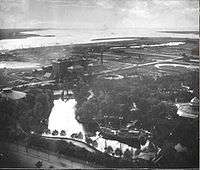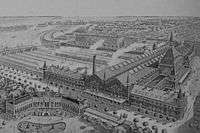Bernstorffsgade

Bernstorffsgade is a street located next to the Central Station and Tivoli Gardens in central Copenhagen, Denmark. It marks the boundary between the districts Indre By (City Centre) and Vesterbro.
History

Bernstorffsgade and the two parallel streets Reventlovsgade and Colbjørnsensgade were established in 1881.[1] The three streets were named after Andreas Peter Bernstorff, Christian Ditlev Frederik Reventlow and Christian Colbjørnsen, three of the driving forces behind the peasant reforms of the 1780s.
.jpg)

Having been located outside Copenhagen's West Tampart in what had been known as Dronningens Enghave, the new street was surrounded by open land, although Tivoli Gardens had opened at the site in 1843. Copenhagen's first railway station opened on the other side of the future street in 1847 but had moved to the other side of Vesterbrogade in 1866. Skandinavisk Panoptikon, a combination of a wax museum and a cabinet of curiosities, was opened at the corner with Vesterbrogade by Vilhelm Pacht in 1885. The building was destroyed in a fire on 4 January 1950. Cyclisten, a cycling club, constructed a 350 metres long cycle-racing track with canted curves, tribunes and restaurant at the street in 1893. It was inaugurated on 22 May and was used for six-hour races for both men and women. It was joined by Copenhagen Goods Station in 1895-1901. The station was designed by DSB's head architect Heinrich Wenck.
The cycle-racing track was torn down in 1904 to make way for the new Central Station which opened in 1911. Bernstorffsgade was originally located a little further to the west (where Banegårdspladsen runs today) but was moved in connection with the construction of the new station.
Notable buildings and structures
The block between Vesterbrogade and Tietgensgade is dominated by Copenhagen Central Station on one side and Tivoli Gardens on the other. The central Station was designed by Heinrich Wenck in the Historicist style. The Panopticon Building was replaced by a new headquarters for Arbejdernes Landsbank in 1954.[2]
Rivoli Gardens has one of its two entrances opposite the Central Station. Next to it is the entrance to the Nimb Complex, featuring Nimb Hotel as well as a Hans Christian Andersen Bakery. The Tivoli Corner, designed by Pei Cobb Freed & Partners, is currently (2017) under construction at the corner with Vesterbrogade. It wil contain new rooms for Hotel Nimb, a food court, restaurants and shops.
Copenhagen Central Post Building, located on the other side of Tietgensgade, was built at the same time as the Central Station and also with Wenck as architect. It was later expanded with a large post terminal in the 1960s. The whole site was sold in 2016. The old Central Post Building will be turned into an upscale hotel while the rest of the area will be cleared to make room for a mixed-use development with offices, hotel and apartments. The project is designed by Lundgaard & Tranberg and comprises several highrises of up to 120 metres.[3] Lundgaard & Tranberg has also designed SEB Bank's tweo buildings at the corner with Kalvebod Brygge.
Across the street from the Central Mail Building is the former Western Power Station (Vestre Elektricitetsværk). Built in 1896-98 for Københavns Belysningsvæsen to design by Ludvig Fenger, it was one of the first power plants in Copenhagen. The fisused plant has been converted into a district cooling plant and administration office for HOFOR, Greater Copenhagen’s largest utility company.[4]
Bernstorffsgade 21 is the former home of The Church Association for the Inner Mission in Denmark. The building is from 1916 and was designed by Arthur Wittmaack. It is now used by Copenhagen Municipality. The neighboring building at No. 23. was designed by Albert Oppenheim. The next building, which fronts Polititorvet (Polititorvet 14), was completed for the insurance company Arbejdsgivernes Ulykkesforsikring in 1914 to design by Knud Arne Petersen. Rigspolitiet is now based in the building. The building on the other side of Polititorvet is the headquarters of Falck.
References
- ↑ "Vester Kvarter14a". Selskabet for Københavns Historie (in Danish). Retrieved 17 January 2017.
- ↑ "Panoptikonbygningen, KøbenhavnKvarter14a". Selskabet for Københavns Historie (in Danish). Retrieved 17 January 2017.
- ↑ "Efter kritik: Mere luft omkring Posttårnene". Magasinet KBH (in Danish). Retrieved 27 January 2017.
- ↑ "Tietgensgade District Cooling Plant". Domus. Retrieved 17 January 2017.
External links
| Wikimedia Commons has media related to Bernstorffsgade. |